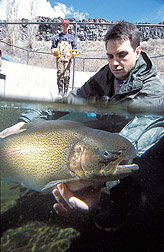|
Healthy Animals 34

Alternative Feeds Initiative
USDA and NOAA Collaborate to Improve Aquaculture Feed
One of the best ways to get high-quality protein and nutritious omega-3 fatty acids is by eating fish. And fish get them the same way humans do.
Both wild and farmed fish get much of their dietary nutrition by eating fish; wild fish consume them as prey, and farmed fish consume fish meal in pellets. This consumption, however, puts pressure on the wild fish that live in the planet's oceans and waterways, so the U.S. Department of Agriculture (USDA) is collaborating with the national Oceanic and Atmospheric Administration (NOAA) to find a solution.
In November 2007, NOAA and USDA announced a joint initiative to promote the development of alternative feeds for aquaculture. The initiative involves two USDA agencies--the Agricultural Research Service (ARS) and the Cooperative State Research, Education, and Extension Service (CSREES).
 |
An ARS geneticist places a trout in the water. |
The goal of this collaboration is to find a nutritional alternative to the fish meal that forms the foundation of many existing aquaculture feeds. Contributors will also promote alternative feed research within the United States and around the world, identify research and development priorities, and improve public awareness.
"This partnership is an important step in the development of alternative aquaculture feed ingredients," says Jeff Silverstein, leader of ARS' National Program for Aquaculture.
The agencies have met with representatives from universities, industry, interested organizations and the general public to identify concerns and outline plans for the future.
ARS scientists have already made major strides in this area, developing nutritious diets using sustainable, plant-derived proteins. Others are investigating whether breeding programs could produce fish more likely to thrive on alternative feed ingredients. ARS researchers have also developed online tools and programs to help feed manufacturers select the best materials to provide nutritious, digestible feed.
The United Nations Food and Agriculture Organization estimates that more than 40 percent of the seafood consumed world-wide is coming from aquaculture, and that production must double to meet the expected demand by the year 2030. As seafood consumption rises in the United States and throughout the world, aquaculture and fishing industries must adjust to meet increased demand.
Click here to sign up for our free quarterly Healthy Animals newsletter! |
For more information about ARS aquaculture research, contact Jeff Silverstein, Leader of ARS National Program #106: Aquaculture.
|